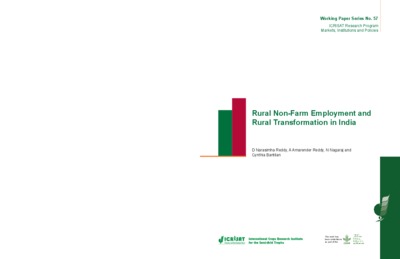Rural Non-Farm Employment and Rural Transformation in India, Working Paper Series No. 57
Abstract
This study attempts to assess the changing structure of rural production and employment in the last two decades and its implications on rural labor market. The rural labor market has undergone profound structural transformation with labor moving from agriculture towards non-agricultural activities. Currently, non-farm sector is no longer a residual sector, but an emerging driver of rural development and transformation, contributing 65% to the rural Net Domestic Product in 2010. There has been an absolute decline in labor force in recent times with a decline in agriculture employment for both male and female laborers and this decline in female workforce is much higher than male workforce in agriculture. The key drivers of changes include inter alia – higher growth in non-farm sector specially infrastructure and construction, coupled with improved transportation and communication, differential wage rates, improved literacy and Government programs. Such change in employment structure also led to occupational shifts among different social groups with increased dependence of SC on rural nonfarm employment mainly construction work, and reduced dependence on agriculture. Tis significant movement of rural labor from farm to non-farm activities and migration from rural areas to cities, especially by male workers to relatively higher wage work, has led to tightening of the labor market. Thus labor scarcity has emerged as one of the major constraints to increasing agricultural production in India. This has several implications on agriculture in terms of rise in farm wage along with other rising input costs pushing the cost of production. Labor market also witnessed some structural transformation such as the disappearance of bonded and attached labor and changing contractual arrangement of rural labor. Casual labor is predominant but increasingly shifting from daily wage to contractual work with increasing bargaining power of labor. Based on empirical results of the study a number of policy interventions are suggested such as development of labor saving technologies and machines to mitigate labor scarcity, inclusive farm mechanization program, especially for women and youth, strengthening rural-urban connectivity, social protection to migrant labor and capacity building programs for skill augmentation

